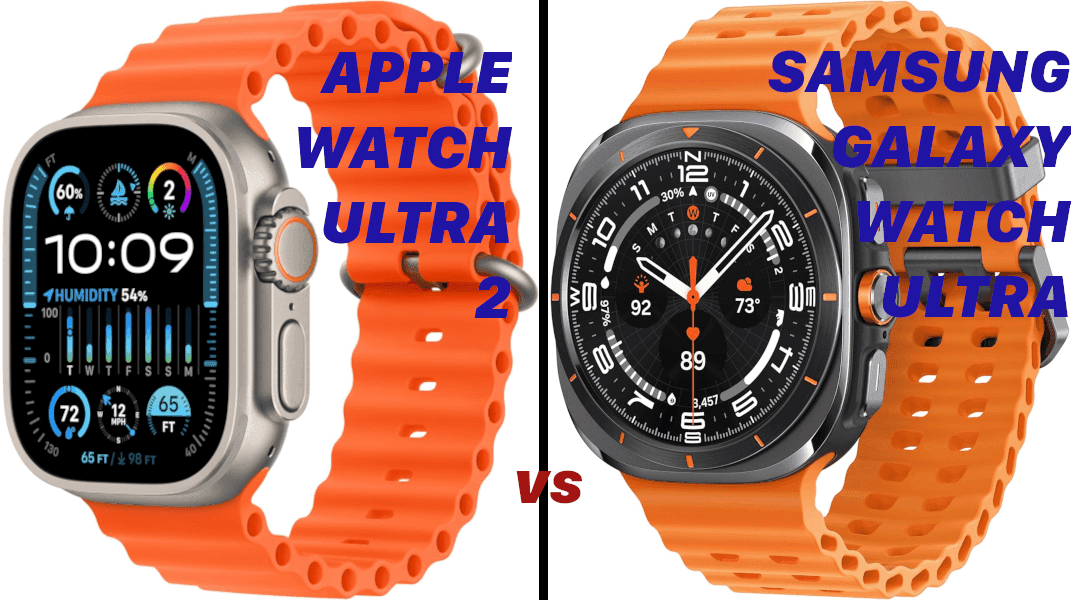Rolex? Nahh. The Apple Watch Ultra 2 and the Samsung Galaxy Watch Ultra are designed to be the only watches you’ll ever need. With their relentless fitness tracking reminders and extended battery lives, you’re practically encouraged to keep them on at all times. So, I did just that. Over the past few weeks, I’ve alternated between the two, making sure I always had one on my wrist. At times, I even wore both simultaneously, embracing my inner tech-obsessed cyborg, all in an effort to determine which one truly stands out. The answer? Apple and Samsung have reached a near-equal playing field.
Samsung has clearly taken cues from Apple in its latest lineup, with its high-end sports watches even adopting the “Ultra” branding. While this has sparked debate among loyalists from both brands, the reality is, it doesn’t make much difference. If Samsung can replicate a premium experience and still sell it for $150 less than Apple’s version, that’s a win for consumers. I’m not here to arbitrate intellectual property disputes—I just want the best wearable for my needs.
No products found.
No products found.
Samsung’s Ultra-exclusive watch face might offer more customization, but Apple has a significant advantage in one crucial area: analog controls. Both devices boast nearly identical two-day battery life, even with always-on displays enabled. Samsung holds a slight edge in battery longevity and a few additional health-tracking features, but the difference is hardly game-changing. Both come with titanium casings, dual-frequency GPS, programmable buttons, 100-meter water resistance, and advanced multi-sport tracking. The real question remains: how well do they actually track your fitness, especially with Samsung touting its latest improvements?
For Apple users who love outdoor workouts, the choice is clear—the Apple Watch Ultra 2 is the go-to. The same applies to Samsung enthusiasts, who will naturally gravitate toward the Galaxy Watch Ultra. My main curiosity lay in the subtleties: Does one truly offer a better user experience? To find out, I wore both simultaneously during workouts and took them on a three-hour trek through Breakneck Ridge, a challenging trail just south of Beacon, New York.
The differences are subtle—so subtle that comparing them felt like searching for gold in a dried-up stream. Samsung has a lead in sensing capabilities, particularly with its blood oxygen sensor (currently disabled on Apple wearables) and body composition analysis. However, unless you’re specifically testing for sleep apnea, these features won’t drastically change your day-to-day experience.
Design and Comfort
Hiking through Breakneck Ridge, I couldn’t help but admire the stunning views of the Hudson River and the rugged terrain of the Hudson Highlands. But my focus kept shifting back to the two watches, which incessantly buzzed updates on my progress. Both are visually striking, particularly in dark mode, where the glowing red display feels almost futuristic.
Samsung wins on aesthetics, thanks to its circular watch face and highly customizable complications. Both screens are impressively bright, making them easy to read even in direct sunlight. While the Apple Watch Ultra 2 has a 49mm case compared to Samsung’s 47mm, the Galaxy Watch Ultra feels bulkier due to its square frame and 12.1mm thickness. Despite this, it distributes its 60.5-gram weight comfortably across the wrist.
The Apple Watch Ultra, while similarly thick, feels more concentrated in weight at 61.4 grams. It’s not cumbersome, but compared to the Samsung, you’re more aware of its presence. A major win for Apple? The digital crown. It’s an intuitive, seamless way to navigate menus without smudging the screen—a convenience Samsung lacks.
Software and Performance
Both watches are powerhouses, with Samsung eking out a slight lead in battery life. The Apple Watch Ultra 2, powered by the S9 SiP, runs smoothly with zero lag. Samsung’s Galaxy Watch Ultra, equipped with a new 3nm processor, promises triple the speed of its predecessor. Samsung also revamped its sensors, introducing the BioActive Sensor, which claims to enhance tracking accuracy.
My Apple Watch Ultra 2 runs watchOS 10, with watchOS 11 on the horizon, bringing updates like the ability to pause activity rings and a Vitals app for sleep tracking. Samsung’s latest software update introduces sleep apnea detection and ECG tracking—features Apple has yet to implement. While impressive, these won’t replace professional medical assessments.
Samsung also provides body composition tracking, though its accuracy remains questionable. A Samsung-sponsored study claims 97% accuracy, but professional nutritionists are still a more reliable source for such data.
Both watches support a new double-pinch gesture for notifications and app controls. While functional, it takes multiple tries to register properly, with Apple’s implementation proving slightly more responsive.
Apple wins in navigation, with a well-designed compass app featuring Backtrack mode for retracing steps. While I didn’t test underwater capabilities, Apple’s reputation in water resistance is solid.
Battery-wise, Apple conservatively estimates 36 hours per charge, though I managed around 42. Samsung stretched to 46, a minor but notable advantage.
Fitness and Health Tracking
Breakneck Ridge is infamous for its challenging climbs and rocky paths, making it a great test for fitness tracking. Both watches recorded elevation gains consistently, though they disagreed on specifics—Apple logged my peak at 1,218 feet, while Samsung reported 1,270 feet.
Heart rate monitoring also varied. Apple categorized my aerobic heart rate as 145-158 BPM, while Samsung set the range at 134-152 BPM. Apple claimed I spent 24 minutes in the aerobic zone, whereas Samsung clocked me at 33 minutes of vigorous activity.
GPS accuracy was another point of contention. The designated trail length is 3.2 miles, and Samsung’s watch nearly nailed it at 3.13 miles. Apple, however, overestimated at 3.45 miles.
Calorie tracking showed the widest disparity—Apple estimated 546 active calories burned, while Samsung doubled that at 1,126 calories. This variance isn’t surprising, as calorie calculations rely on algorithms rather than direct measurement.
Apple Watch Ultra 2 vs Samsung Galaxy Watch Ultra
| Feature | Apple Watch Ultra 2 | Samsung Galaxy Watch Ultra |
|---|---|---|
| Display | 1.92″ LTPO OLED, Always-On | 1.5″ AMOLED, Always-On |
| Resolution | 502 x 410 pixels | 480 x 480 pixels |
| Battery Life | 36 hours (normal), 72 hours (low-power) | 48 hours (normal), 100 hours (power-saving) |
| Processor | Apple S9 SiP | Exynos W930 |
| Operating System | watchOS 10 | Wear OS 4 with One UI |
| Water Resistance | 100m (WR100), EN13319 certified | 50m (5ATM) + IP68 |
| Health Sensors | Heart rate, ECG, SpO2, temperature | Heart rate, ECG, SpO2, temperature |
| GPS | Dual-frequency GPS (L1 + L5) | Dual-band GPS |
| Connectivity | Wi-Fi, Bluetooth 5.3, LTE (optional) | Wi-Fi, Bluetooth 5.3, LTE (optional) |
| Price | $799 | $649 |
The Verdict
Both watches are premium, feature-packed, and—let’s be real—expensive. Samsung’s biggest advantage is its lower price and slightly better battery life. However, Apple’s digital crown and superior usability make it a strong contender.
Samsung would do well to reintroduce the rotating bezel for better navigation in future iterations. Until then, the Apple Watch Ultra 2 remains the more refined experience, while Samsung’s offering is a close second that still provides excellent value for its price.
At the end of the day, the best watch depends on your ecosystem. Apple users will find comfort in the seamless integration of the Watch Ultra 2, while Samsung fans will appreciate the Galaxy Watch Ultra’s compelling features and savings. Either way, you’re getting a top-tier smartwatch that won’t disappoint.
Last update on 2025-11-30 at 03:44. Disclosure

